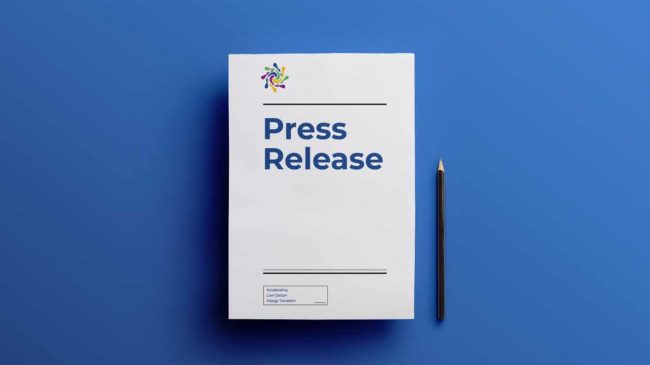Jakarta, 18 October 2022- Under the Paris Agreement, Indonesia needs significant financing to achieve its zero emissions target by 2050. The Institute for Essential Services Reform (IESR), through its latest report, Indonesia Sustainable Finance 2023, examines that to optimise public financing, the Indonesian government needs to immediately mobilize non-government investment by establishing policies, regulations, and an attractive investment ecosystem.
Fabby Tumiwa, Executive Director of IESR, said that the Indonesian government needs to make a transformative and massive effort to completely decarbonize the energy system by raising around USD 1 .2 trillion by 2050. Based on a study by IESR & the University of Maryland, the cost of ending 9.2 GW of coal-fired power plants (CFPP) in 2022-2030 requires around USD 4.6 billion. Furthermore, early retirement of all CFPPs in 2045 with an average age of 20 years requires USD 28 billion to compensate for stranded assets and the cost of decommissioning coal power plants.
Fabby explained that some efforts to end the CFPP operational period should be accompanied by an increase in the addition of renewable energy plants, strengthening of transmission and distribution networks, and massive energy efficiency.
“We need USD 135 billion for CFPP retirement in the 2022-2023 period, the increase of renewable energy, development of transmission and distribution, energy storage, and energy efficiency,” he said.
On the other hand, the government’s budget portion will only be able to allocate 0.83% of the total financing needed to achieve the target of 23% of the renewable energy mix by 2025 based on ISFO 2023. It refers to the average budget allocation for climate change mitigation of the Directorate General of New Renewable Energy and Energy Conservation of the Ministry of Energy and Mineral Resources in 2018-2020, amounting to USD 67 million per year.
Farah Vianda, one of the authors of ISFO 2023, revealed that the same trend is also taking place at the provincial level. She gave an example of Central Java as one of the provinces that supports the development of renewable energy the most. Still, fiscal constraints make Central Java allocate less than 0.1% of the total available Regional Revenues and Expenditures Budget (APBD).
“This encourages local governments to seek financing outside the Regional Revenues and Expenditures Budget. The Indonesian government also needs to make the same effort by expanding funding sources to attract investment in the renewable energy sector,” she stated.
In addition, she also explained that so far, the Regional Revenues and Expenditures Budget allocation is still dominantly targeting the fossil energy sector, including spending 5% of the Regional Revenues and Expenditures Budget throughout 2021 for fossil energy subsidies and 20.8% subsidies from the Regional Revenues and Expenditures Budget when the projections of the Ministry of Finance are related to the need for energy subsidies. There will be Rp649 trillion in 2022 realized. Not only that, Indonesia’s dependence on coal will be one of the challenges in implementing blended finance instruments (Energy Transition Mechanism).
“Currently, Indonesia is experiencing an excess electricity supply which makes PLN reluctant to build renewable energy plants. While on the other hand, investors in the ETM platform want to encourage renewable energy development,” Farah said.
Meanwhile, Ichsan Hafiz Loeksmanto, the Lead Author of ISFO 2023, explained that implementing a carbon tax, the cap, and the trade mechanism (limit and business) on 92 coal-fired power plants in 2022, the carbon tax revenue was non-taxable. It was not earmarked. Carbon tax revenues have not been devoted to financing climate change mitigation and adaptation efforts.
“The government needs to ensure the allocation of carbon tax revenues for climate mitigation & adaptation and social safety nets. In addition, public transparency regarding payment of carbon taxes and carbon transactions is also necessary,” said Ichsan.
Talking about international support, based on IESR’s calculation in ISFO 2023, there is a potential for international funding of USD 13.1 billion or 35.4% of the total projected financing needs of USD 36.95 billion in 2025.
“The promises voiced by nine countries to support the energy transition in Indonesia through various financing instruments and technical support are quite a positive signal from the international community regarding the energy transition in Indonesia,” explained Ichsan.
One financing encouraged by the private sector is Indonesian financial institutions, increasing public pressure to shift financing to clean energy. However, until 2021, financial institutions, especially domestic commercial banks in Indonesia, will only finance limited renewable energy projects. ISFO 2023 noted that renewable energy financing only contributed 0.9%-5.5% of the total sustainable portfolio of four domestic and commercial banks with the highest total asset value in 2021, namely Bank Mandiri, BNI, BRI, and BCA.
“To increase the allocation of renewable energy credit from the banking sector, the government must prepare comprehensive guidelines to encourage credit allocation for renewable energy. They also need to increase business credit opportunities from banks (bankability) for renewable energy projects and increase awareness and confidence of domestic investors to invest in renewable energy,” he explained.
In addition to the carbon tax mechanism, support from financial institutions in Indonesia, and international financing, ISFO 2023 also discusses green taxonomy, green bonds, and green sukuk as part of the opportunity to attract funding for the energy transition in Indonesia.
The Indonesia Sustainable Finance 2023 report is IESR’s main report, first launched in 2022. Since 2018, IESR has consistently reported on the development of the energy transition in Indonesia through the Indonesia Clean Energy Outlook report from 2017 to 2019, which was later transformed into the Indonesia Energy Transition Outlook in 2020. The ISFO 2023 report can be downloaded at s.id/ISFO2023.

